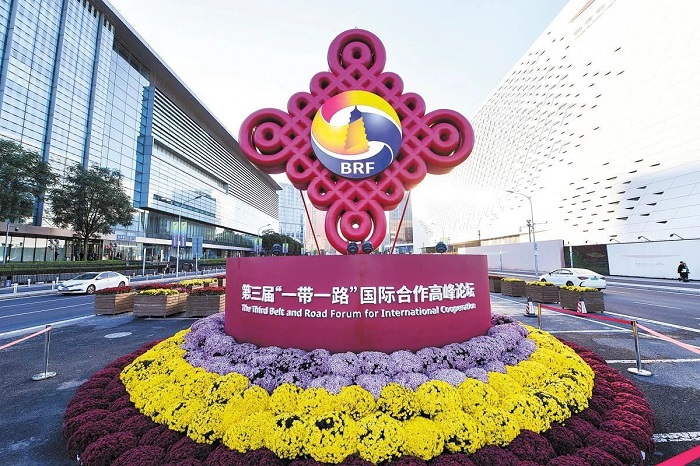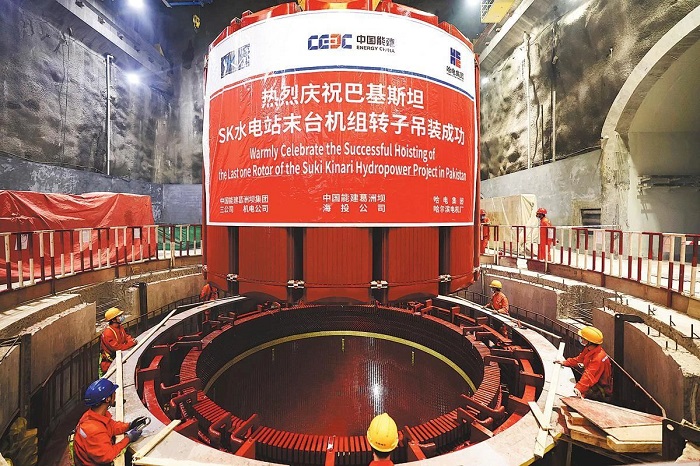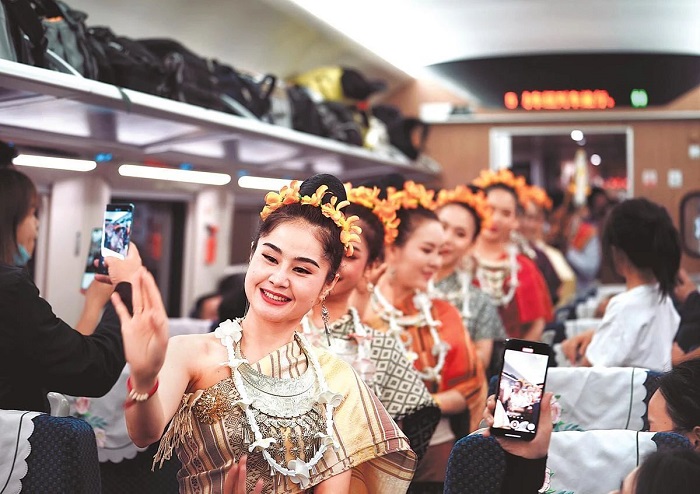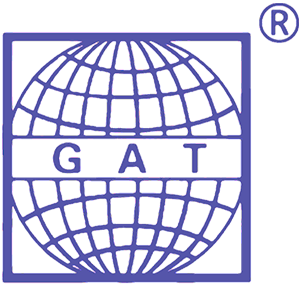When President Xi Jinping presented his vision 10 years ago for the Silk Road Economic Belt, few might have imagined the global implications of the policy address, delivered to faculty and students at Nazarbayev University in Kazakhstan.

▲A floral arrangement for the third Belt and Road Forum for International Cooperation is seen near Beijing's National Convention Center on Saturday. [Photo/Xinhua]
In the eyes of many analysts, the speech marked a historic starting point to reshape the global economic landscape, heralding changes leading to infrastructure connectivity, unimpeded trade, financial integration and closer people-to-people ties.
▲The mega container ship OOCL Piraeus docks in Piraeus, Greece's largest port, in July. [Photo/Xinhua]A month later, during a speech to the Indonesian Parliament, the Chinese president expounded his vision for the 21st Century Maritime Silk Road, which, together with the Silk Road Economic Belt, became known as the Belt and Road Initiative.Ten years on, Xi is set to host representatives from over 140 countries and 30 international organizations at the third Belt and Road Forum for International Cooperation on Tuesday and Wednesday in Beijing.
▲The last rotor of the Suki Kinari Hydropower Project, a flagship project of the China-Pakistan Economic Corridor, is hoisted on June 10. [Photo/Xinhua]Regarding the Silk Road Economic Belt and the 21st Century Maritime Silk Road, Tatiana Urzhuvtseva, former director of the research center of China and the Pacific Rim at St. Petersburg State University of Economics, said, "Looking back, one cannot but feel assured that those were truly historic initiatives in favor of goodwill cooperation between nations."Urzhuvtseva, who is now head of the Russian Culture Center in Beijing, said the personal role of President Xi in leading the development of the BRI cannot be overstated.Xu Xiujun, director of the International Political Economy Department of the Chinese Academy of Social Sciences' Institute of World Economics and Politics, said the Chinese president has personally planned and promoted the BRI's transition into a new stage of high-quality development.Through his intense diplomatic agenda, Xi, on bilateral and multilateral occasions, has promoted high-level policy coordination and strategic alignment, created a favorable international environment and established a solid political foundation for the steady and long-term development of the BRI, Xu said.
▲Attendants on a train car of the China-Laos Railway present a performance for passengers in April. [Photo/Xinhua]Over the past decade, more than 150 countries and over 30 international organizations have joined the BRI family, with many agreements inked during bilateral meetings attended by the Chinese president.The BRI has taken much-anticipated infrastructure projects from vision to reality in much of the developing world, ranging from bridges, highways and railways to hospitals and sports stadiums. It has created 420,000 jobs for participating countries and lifted about 40 million people out of poverty.The China-Laos Railway, for instance, has employed over 3,500 Laotian workers and created more than 100,000 jobs through its impact on logistics, transportation, trade, commerce and tourism.
▲Workers bolster tracks for a section of the Chinese-built Hungary-Serbia Railway in Kunszentmiklos, Hungary, in May. [Photo/Xinhua]Charles Okechukwu Onunaiju, director of the Center for China Studies in Nigeria, said that through participation in the Belt and Road, key projects including highways, ports and energy infrastructure are remarkably taking shape in West Africa."The BRI is the concentrated expression of globalization in its broadest sense of accommodation, inclusion and participation, and it carries Africa's fervent historic wish and will," he said. "In the past 10 years, Africa has witnessed the most impactful revolution in infrastructure construction and facilities connectivity."President Xi hosted global leaders at the first Belt and Road Forum for International Cooperation in Beijing in 2017, and at the second Belt and Road Forum in 2019 in Beijing, both times delivering speeches that outlined the future road map for BRI cooperation.The BRI has also been a priority of Xi's domestic agenda, with the president having chaired high-level symposiums three times on promoting the high-quality development of the landmark initiative.Hu Biliang, executive dean of the Belt and Road School at Beijing Normal University, said the BRI has led the way for China's greater strides in opening-up and emerged as a key part of the national drive to foster a new development paradigm.According to a white paper released earlier this month, the cumulative value of imports and exports between China and BRI partner countries reached $19.1 trillion, with an average annual growth rate of 6.4 percent.Building a better regional connectivity network will inject new momentum into the development of a more open and in-depth partnership between China and other countries participating in the BRI, Hu said.Reporter: Xu Wei





